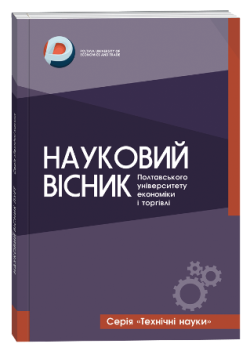THE USE OF CARROT POWDERS TO ENRICH MILK WITH MINERAL ELEMENTS
Abstract
Milk is the main source of protein and a must-have in the daily diet of children. It is recommended to consume milk with added vitamins and minerals. That is why milk fortification is a topical issue. The purpose of the study is to substantiate the expediency of using carrot powders for enriching milk with minerals. Milk quality indicators were determined according to standard methods: organoleptic assessment was carried out according to DSTU 2661: 2010, titrated acidity was determined according to DSTU 8550: 2015. Chemical analysis of powders was carried out by electron microscopy using SEM and EDS detectors. Powders were made from the root crops of Shantane carrots and their skins under laboratory conditions and a technology for enriching A2 milk with them was developed. Analysis of the chemical composition showed that carrot powders from the main part of root crops contain K (27.1%), Ca (6.97%), Cl (5.09%), P (3.82%), Na (3.3%), Fe (1.07%), Mg (0.75%) and S (0.47%). It was found that the addition of carrot root vegetable powder in the amount of 10% had a positive effect on the organoleptic properties of milk without reducing its storage capacity. The fortified milk had a characteristic pasteurized smell, a pleasant creamy color, and a slight carrot flavor. The consistency of the developed product corresponded to that of pasteurized milk. It was found that some mineral substances in carrot peel powders contain more than in the main part of the root crop: K – by 4.28%, Fe – by 0.73%, P – by 0.45%, S – by 0.12%. But the addition of such powders to milk significantly reduces its quality indicators and leads to rapid deterioration of the product. The sample with carrot waste powder had a dirty tint and a characteristic vegetable taste and aroma. The acidity of milk with the addition of powder from carrot skins exceeded the standard value by 4°Т. This technology can be waste-free, in the case of drying the carrot pulp obtained after filtering milk and using it as a food additive. The development of a technology for using dried carrot pulp is a prospect for further research.
References
2. Clare M. Hasler. Functional Foods: Benefits, Concerns and Challenges – A Position Paper from the American Council on Science and Health. The Journal of Nutrition. 2002 Vol. 132. Iss. 12. P. 3772–3781. https://doi.org/10.1093/jn/132.12.3772
3. Fa-Ming Chen, Xiaohua Liu. Advancing biomaterials of human origin for tissue engineering. Progress in Polymer Science. 2015. Vol. 53. P. 86–168. doi: 10.1016/j.progpolymsci.2015.02.004.
4. Jung Tae-Hwan, Hwang Hyo-Jeong, Yun Sung-Seob, Lee Won-Jae, Kim Jin-Wook, Ahn Ji-Yun, Jeon Woo-Min, Han Kyoung-Sik. Hypoallergenic and Physicochemical Properties of the A2 β-Casein Fractionof Goat Milk. Korean Journal for Food Science of Animal Resources. 2017. Vol. 37 (6). Р. 940–947. doi:10.5851/kosfa.2017.37.6.940.
5. Kamiński S., Cieslińska A., Kostyra E. Polymorphism of bovine beta-casein and its potential effect on human health. Journal of Applied Genetics. 2007. Vol. 48:1. Р. 89–98. DOI: 10.1007/BF03195213.
6. Бирюкова З.А., Коваленко Л.М., Пантелеева О.Г. Сохранность витаминов, микроэлементов и кальция при производстве и хранении обогащенных стерилизованных молочных продуктов. Молочное дело. 2007. № 8. C. 18–19.
7. Фіалковська Л.В. Дослідження і розробка технології збагаченого молока. Техніка, енергетика, транспорт АПК. 2018. № 4. Вип. 103. С. 51–56.
8. Способ получения обогащенного пастеризованного молока: пат. Росія : МПК A23C 3/02. A23C 9/152. № 2290818 ; заявл. 10.02.06; опубл. 10.01.07, Бюл. № 1. 5 с
9. Пономарев Е.Е., Козлов В.Н., Пономарева Л.Ф. Технология производства ультрапастеризованного молоко, обогащенного йодом. Технічні науки: стан, досягнення і перспективи розвитку м’ясної, олієжирової та молочної галузей : мат. ІІ міжнар. наук.-техн. конф., 21 березня 2013 р. м. Київ: НУХТ, 2013. С. 74–76.
10. Способ получения лечебного продукта на основе молока : пат. Росія : МПК А 23 С 9/13. № 2079222 ; заявл. 30.11.94; опубл. 10.05.97.
11. Активация гидрофильных свойств каротиноидов растительного сырья : монография / В.В. Погарская, Р.Ю. Павлюк, А.И. Черевко, В.А. Павлюк, Н.Ф. Максимова. Харьков, 2013. 345 с.
12. Ладика Л.М., Машкін М.І., Могутова В.Ф., Богомолов О.В., Денисенко С.А. Розробка технології пастеризованого молока з додаванням ваніліну і β-каратину. Вісник Харківського національного технічного університету сільського господарства ім. Петра Василенка. 2016. Вип. 179. С. 90–100.
13. Українцева Ю.С., Гросу Є.І. Білкова паста для дитячого харчування з подовженим терміном зберігання. Збірник наукових праць молодих учених, аспірантів та студентів. Одеса : ОНАХТ, 2014. С. 194–196
14. Combet E., Buckton C. Micronutrient deficiencies, vitamin pills and nutritional supplements. Medicine. 2019. Vol. 47 (3). Р. 145–151.
15. Pavlyuk R., Pogarska V., Radchenko L., Tauber R.D., Timofeyeva N. Deep Processing of Carotene-Containing Vegetables and Obtaining Nanofood With the Use of Equipment of New Generation. Eastern-European Journal of Enterprise Technologies. 2016. Vol. 4, № 11(82). Р. 36–43. doi:10.15587/1729-4061.2016.76232.
16. Perrin F. et al. Carotenoid gene expression explains the difference of carotenoid accumulation in carrot root tissues. Planta. 2017. Vol. 245. Р. 737–747. DOI:10.1007/s00425-016-2637-9.
17. Снєжкін Ю.Ф., Петрова Ж.О., Пазюк В.М. Гідротермічна обробка функціональної сировини. Наукові праці. 2012. Вип. 41 (1). С. 13–17.
18. Elsner Р. Oxidants and Antioxidants in Cutaneous Biology. J Thiele Current Problems in Dermatology. London, 2001. Vol. 29.
19. Про затвердження Правил додавання вітамінів, мінеральних речовин та деяких інших речовин до харчових продуктів: Наказ від 16.07.2020 р. № 1613 / Міністерство охорони здоров’я України. URL: https://zakon.rada.gov.ua/laws/show/z0891-20#Text.
20. ТУ У 01.4-04718013-001:2020. Молоко А2 незбиране. Технічні умови. Суми, 2020. 23 с.


